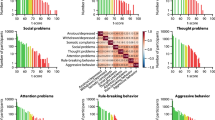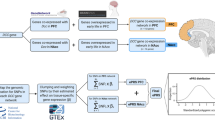Abstract
The impulsive behavior that is often characteristic of adolescence may reflect underlying neurodevelopmental processes. Moreover, impulsivity is a multi-dimensional construct, and it is plausible that distinct brain networks contribute to its different cognitive, clinical and behavioral aspects. As these networks have not yet been described, we identified distinct cortical and subcortical networks underlying successful inhibitions and inhibition failures in a large sample (n = 1,896) of 14-year-old adolescents. Different networks were associated with drug use (n = 1,593) and attention-deficit hyperactivity disorder symptoms (n = 342). Hypofunctioning of a specific orbitofrontal cortical network was associated with likelihood of initiating drug use in early adolescence. Right inferior frontal activity was related to the speed of the inhibition process (n = 826) and use of illegal substances and associated with genetic variation in a norepinephrine transporter gene (n = 819). Our results indicate that both neural endophenotypes and genetic variation give rise to the various manifestations of impulsive behavior.
This is a preview of subscription content, access via your institution
Access options
Subscribe to this journal
Receive 12 print issues and online access
$209.00 per year
only $17.42 per issue
Buy this article
- Purchase on Springer Link
- Instant access to full article PDF
Prices may be subject to local taxes which are calculated during checkout




Similar content being viewed by others
References
Spear, L.P. The adolescent brain and age-related behavioral manifestations. Neurosci. Biobehav. Rev. 24, 417–463 (2000).
Patton, G.C. et al. Global patterns of mortality in young people: a systematic analysis of population health data. Lancet 374, 881–892 (2009).
Tarter, R.E. et al. Neurobehavioral disinhibition in childhood predicts early age at onset of substance use disorder. Am. J. Psychiatry 160, 1078–1085 (2003).
O'Shea, M., Singh, M.E., McGregor, I.S. & Mallet, P.E. Chronic cannabinoid exposure produces lasting memory impairment and increased anxiety in adolescent but not adult rats. J. Psychopharmacol. 18, 502–508 (2004).
Johnston, L.D., O'Malley, P.M., Bachman, J.G. & Schulenberg, J.E. Monitoring the future: national results on adolescent drug use. Overview of key findings, 2008 (NIH publication no. 09-7401) (National Institute on Drug Abuse, Bethesda, Maryland, 2009).
Overbey, G.A., Snell, W.E. & Callis, K.E. Subclinical ADHD, stress, and coping in romantic relationships of university students. J. Atten. Disord. 15, 67–78 (2011).
Ivanov, I., Schulz, K.P., London, E.D. & Newcorn, J.H. Inhibitory control deficits in childhood and risk for substance use disorders: a review. Am. J. Drug Alcohol Abuse 34, 239–258 (2008).
Logan, G.D. On the ability to inhibit thought and action: a user's guide to the stop signal paradigm. Inhibitory Processes in attention, Memory and Language (eds. Dagenbach, D. & Carr, T.H.) 189–236 (San Diego, Academic Press, 1994).
Rubia, K., Smith, A.B., Brammer, M.J., Toone, B. & Taylor, E. Abnormal brain activation during inhibition and error detection in medication-naive adolescents with ADHD. Am. J. Psychiatry 162, 1067–1075 (2005).
Fillmore, M.T. & Rush, C.R. Impaired inhibitory control of behavior in chronic cocaine users. Drug Alcohol Depend. 66, 265–273 (2002).
Goudriaan, A.E., Oosterlaan, J., de Beurs, E. & van den Brink, W. Neurocognitive functions in pathological gambling: a comparison with alcohol dependence, Tourette syndrome and normal controls. Addiction 101, 534–547 (2006).
Aron, A.R. From reactive to proactive and selective control: developing a richer model for stopping inappropriate responses. Biol. Psychiatry 69, 55–68 (2011).
Paus, T. Mapping brain maturation and cognitive development during adolescence. Trends Cogn. Sci. 9, 60–68 (2005).
Braet, W. et al. Functional developmental changes underlying response inhibition and error-detection processes. Neuropsychologia 47, 3143–3151 (2009).
Aron, A.R. The neural basis of inhibition in cognitive control. Neuroscientist 13, 214–228 (2007).
Dalley, J.W., Everitt, B.J. & Robbins, T.W. Impulsivity, compulsivity, and top-down cognitive control. Neuron 69, 680–694 (2011).
Lee, S.S., Humphreys, K.L., Flory, K.R., Liu, R. & Glass, K. Prospective association of childhood attention-deficit/hyperactivity disorder (ADHD) and substance use and abuse/dependence: a meta-analytic review. Clin. Psychol. Rev. 31, 328–341 (2011).
Aron, A.R., Fletcher, P.C., Bullmore, E.T., Sahakian, B.J. & Robbins, T.W. Stop-signal inhibition disrupted by damage to right inferior frontal gyrus in humans. Nat. Neurosci. 6, 115–116 (2003).
Zhang, S. & Li, C.S. Functional networks for cognitive control in a stop signal task: independent component analysis. Hum. Brain Mapp. 33, 89–104 (2012).
Congdon, E. et al. Engagement of large-scale networks is related to individual differences in inhibitory control. Neuroimage 53, 653–663 (2010).
Aron, A.R. & Poldrack, R.A. Cortical and subcortical contributions to stop signal response inhibition: role of the subthalamic nucleus. J. Neurosci. 26, 2424–2433 (2006).
Li, C.S., Huang, C., Constable, R.T. & Sinha, R. Imaging response inhibition in a stop-signal task: neural correlates independent of signal monitoring and post-response processing. J. Neurosci. 26, 186–192 (2006).
Bellgrove, M.A., Hester, R. & Garavan, H. The functional neuroanatomical correlates of response variability: evidence from a response inhibition task. Neuropsychologia 42, 1910–1916 (2004).
Kelly, A.M.C. et al. Competition between functional brain networks mediates behavioral variability. Neuroimage 39, 527–537 (2008).
Li, C.S., Yan, P., Bergquist, K.L. & Sinha, R. Greater activation of the “default” brain regions predicts stop signal errors. Neuroimage 38, 640–648 (2007).
Peters, J. et al. Lower ventral striatal activation during reward anticipation in adolescent smoker. Am. J. Psychiatry 168, 540–549 (2011).
Konrad, K. & Eickhoff, S.B. Is the ADHD brain wired differently? A review on structural and functional connectivity in attention deficit hyperactivity disorder. Hum. Brain Mapp. 31, 904–916 (2010).
Albrecht, B. et al. Action monitoring in boys with ADHD, their nonaffected siblings and normal controls: evidence for an endophenotype. Biol. Psychiatry 64, 615–625 (2008).
Bevilacqua, L. et al. A population-specific HTR2B stop codon predisposes to severe impulsivity. Nature 468, 1061–1066 (2010).
Friedman, N.P. et al. Individual differences in executive function are almost entirely genetic in origin. J. Exp. Psychol. Gen. 137, 201–225 (2008).
Ersche, K.D. et al. Abnormal brain structure implicated in stimulant drug addiction. Science 335, 601–604 (2012).
Chamberlain, S.R. et al. Neurochemical modulation of response inhibition and probabilistic learning in humans. Science 311, 861–863 (2006).
Ramoz, N. et al. A haplotype of the norepinephrine transporter (Net) gene Slc6a2 is associated with clinical response to atomoxetine in attention-deficit hyperactivity disorder (ADHD). Neuropsychopharmacology 34, 2135–2142 (2009).
Monti, P.M. et al. Adolescence: booze, brains, and behavior. Alcohol. Clin. Exp. Res. 29, 207–220 (2005).
Schoenbaum, G. & Shaham, Y. The role of orbitofrontal cortex in drug addiction: a review of preclinical studies. Biol. Psychiatry 63, 256–262 (2008).
Rolls, E.T. The orbitofrontal cortex and reward. Cereb. Cortex 10, 284–294 (2000).
Goldstein, R.Z. & Volkow, N.D. Drug addiction and its underlying neurobiological basis: neuroimaging evidence for the involvement of the frontal cortex. Am. J. Psychiatry 159, 1642–1652 (2002).
Franklin, T.R. et al. Decreased gray matter concentration in the insular, orbitofrontal, cingulate, and temporal cortices of cocaine patients. Biol. Psychiatry 51, 134–142 (2002).
Crombag, H.S., Gorny, G., Li, Y., Kolb, B. & Robinson, T.E. Opposite effects of amphetamine self-administration experience on dendritic spines in the medial and orbital prefrontal cortex. Cereb. Cortex 15, 341–348 (2004).
Robinson, T.E., Gorny, G., Mitton, E. & Kolb, B. Cocaine self-administration alters the morphology of dendrites and dendritic spines in the nucleus accumbens and neocortex. Synapse 39, 257–266 (2001).
Tapert, S.F. & Brown, S.A. Neuropsychological correlates of adolescent substance abuse: four-year outcomes. J. Int. Neuropsychol. Soc. 5, 481–493 (1999).
Scangos, K.W. & Stuphorn, V. Medial frontal cortex motivates, but does not control, movement initiation in the countermanding task. J. Neurosci. 30, 1968–1982 (2010).
Chamberlain, S.R. et al. Atomoxetine modulates right inferior frontal activation during inhibitory control: a pharmacological functional magnetic resonance imaging study. Biol. Psychiatry 65, 550–555 (2009).
Diamond, A. & Lee, K. Interventions shown to aid executive function development in children 4 to 12 years old. Science 333, 959–964 (2011).
Schumann, G. et al. The IMAGEN study: reinforcement-related behavior in normal brain function and psychopathology. Mol. Psychiatry 15, 1128–1139 (2010).
Maldjian, J.A., Laurienti, P.J., Burdette, J.B. & Kraft, R.A. An automated method for neuroanatomic and cytoarchitectonic atlas-based interrogation of fMRI data sets. Neuroimage 19, 1233–1239 (2003).
Tzourio-Mazoyer, N. et al. Automated anatomical labeling of activations in SPM using a macroscopic anatomical parcellation of the MNI MRI single-subject brain. Neuroimage 15, 273–289 (2002).
Lancaster, J.L. et al. Automated Talairach atlas labels for functional brain mapping. Hum. Brain Mapp. 10, 120–131 (2000).
Osborne, J.W. & Costello, A.B. Best practices in exploratory factor analysis: four recommendations for getting the most from your analysis. Pract. Assess. Res. Eval. 10, 1–9 (2005).
Band, G.P.H., van der Molen, M.W. & Logan, G.D. Horse-race model simulations of the stop-signal procedure. Acta Psychol. (Amst.) 112, 105–142 (2003).
American Psychiatric Association. Diagnostic Statistical Manual of Mental Disorders, 4th edn. (Washington, DC, 1994).
Goodman, R., Ford, T., Richards, H., Gatward, R. & Meltzer, H. The development and well-being assessment: description and initial validation of an integrated assessment of child and adolescent psychopathology. J. Child. Psychol. Psychiatry 41, 645–655 (2000).
Goodman, A., Heiervang, E., Collishaw, S. & Goodman, R. The 'DAWBA bands' as an ordered-categorical measure of child mental health: description and validation in British and Norwegian samples. Soc. Psychiatry Psychiatr. Epidemiol. 46, 521–532 (2011).
Hibell, B. et al. The 1995 ESPAD report: alcohol and other drug use among students in 26 European countries (Swedish Council for Information on Alcohol and Other Drugs, Stockholm, 1997).
Churchill, G.A. & Doerge, R.W. Empirical thresholds for quantitative trait mapping. Genetics 138, 963–971 (1994).
Acknowledgements
The IMAGEN study receives research funding from the European Community's Sixth Framework Programme (LSHM-CT-2007-037286). Further support was provided by the FP7 projects ADAMS (genomic variations underlying common neuropsychiatric diseases and disease-related cognitive traits in different human populations; 242257) and the Innovative Medicine Initiative Project EU-AIMS (115300-2), as well as the UK National Institute for Health Research Biomedical Research Centre Mental Health and the Medical Research Council Programme Grant 'Developmental pathways into adolescent substance abuse' (93558).
Author information
Authors and Affiliations
Consortia
Contributions
H.G., T.W.R. and G.S. conceived the study. P.J.C., H.G., T.W.R. and R.W. designed the study. M.F.-B., H.G. and T.W.R. carried out the functional neuroimaging. G.J.B., C.B., P.J.C., H.F., J.G., H.G., A.H., B.I., E.L., K.M., J.-L.M, F.N., M.N.S., T.P., M.R., R.S., D.S., T.W.R., M.S. and A.S. acquired the data. J.-B.P., B.T. and R.W. carried out neuroimaging data processing and analysis. M.B., M.F.-B., E.C.L., M.S. and S.V.-K. analyzed behavioral data. M.A.B., T.D.R.C., M.L., A.L. and G.S. carried out genotyping and genetic analysis. R.W. and H.G. prepared the manuscript. M.A.B., P.J.C., T.B., T.P., T.W.R. and G.S. edited the manuscript.
Corresponding authors
Ethics declarations
Competing interests
G.J.B. received honoraria for teaching from General Electric during the course of this study. T.W.R. consults for Cambridge Cognition, E Lilly, GlaxoSmithKline, Merck and Lundbeck and has received recent research grants from Lilly, GSK and Lundbeck. T.B. served in an advisory or consultancy role for Bristol Myers-Sqibb, Develco Pharma, Lilly, Medice, Novartis, Shire and Viforpharma and received conference attendance support and conference support or received speaker's fee from Lilly, Janssen McNeil, Medice, Novartis and Shire. He is/has been involved in clinical trials conducted by Lilly and Shire. The present work is unrelated to the T.B.'s grants and relationships.
Additional information
Institute of Psychiatry, King's College London, London, UK.
Supplementary information
Supplementary Text and Figures
Supplementary Tables 1–13 (PDF 144 kb)
Rights and permissions
About this article
Cite this article
Whelan, R., Conrod, P., Poline, JB. et al. Adolescent impulsivity phenotypes characterized by distinct brain networks. Nat Neurosci 15, 920–925 (2012). https://doi.org/10.1038/nn.3092
Received:
Accepted:
Published:
Issue Date:
DOI: https://doi.org/10.1038/nn.3092



